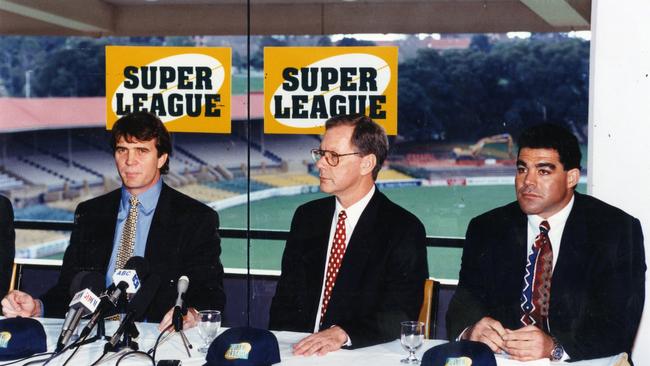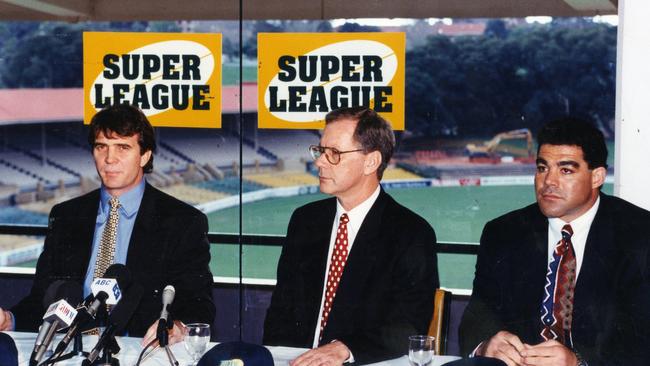How Super League salaries helped spark a cricket pay war 25 years ago
As rugby league prepares to tighten the belt in order to get through the coronavirus pandemic, ROBERT CRADDOCK looks back at the far-reaching impact of the salary explosion of Super League.

Teams
Don't miss out on the headlines from Teams. Followed categories will be added to My News.
Talk about a bizarre coincidence.
As NRL players prepare for 20 per cent pay cuts to their annual salaries, the game has reached the 25th anniversary of the year when payments surged in the other direction, spinning so far out of control one lucky player unintentionally bagged a $70,000-a-year pay rise simply for having a stutter.
True story. It happened during the Super League war in 1995 when a Queensland-based player without a manager met with officials who were desperate for his signature.
The initial offer was around $120,000 a year which was such a dramatic increase on what he was earning he was literally rendered speechless.
When he did start talking his stutter kicked in and he simply started making a series of "ahhhs and ummms'' which made the man on the other side of the table think he was indecisive.
Relive classic NRL matches from the 60s to today on KAYO SPORTS. New to Kayo?
Get your 14-day free trial & start streaming instantly >

The offer was raised a couple of times before it reached $190,000 with the message that it was the "final'' bid for his services at which point the player squeezed out "da-da-done deal'' and left the room to tell his teammates the story with a smile and bewildered shake of his head.
The ARL and Super League teams scrambled for signatures in a frenzied bunfight the likes of which have never been seen before or since and the ripples flowed all the way to the West Indies where Mark Taylor's tourists were about to end the West Indies 15-year dominance of world cricket.
The rugby league boys never knew it at the time but their payments helped to trigger the cricket pay war which followed a year or two later.
I was waiting for a fax in the office of a Barbados hotel when a faxed batch of morning headlines arrived for the players from Australia including the fact that Canberra's Laurie Daley and Ricky Stuart had been offered deals worth $600-$700,000 a season with Super League.
The looks on the two players waiting for the faxes said more than any spoken word. They were gobsmacked by the size of the figures, especially since Allan Border had retired from Tests the previous year on a final contract of just $90,000 a year.

Those hastily snatched faxes did the rounds at breakfast and galvanised the players desire to fight for more pay and a subsequently ugly, and protracted war with Cricket Australia ensued.
But for rugby league, dollars rained down upon the sport during the Super League as if they were shot out of a fire hydrant.
Steve Edmed, hoping to land a $40,000 deal for one last season with Balmain, got $1 million to join the Cowboys.
In Super League: The Inside Story journalist and author Mike Colman revealed Steve Walters was so shocked by the size of his cheque he paid an extra $15 to have it quickly cleared in case something happened and the Super League venture went belly up overnight.
Ben Ikin, who at 18 was on the verge of becoming Queensland's youngest State of Origin player, remembers the madness of it all.
“Super League came when I was playing for the Gold Coast Seagulls and it was my first year out of high school,” Ikin said.
“I was on $2000 for the year and that helped me to buy a car, pay university fees and get a job.
“I played State of Origin in 1995 and I collected $22,500 in three games playing for Queensland when I was being paid $2000 for the season. My head was spinning.
“Then I went to the North Sydney Bears in 1996 and earnt double what my father was earning and he was a removalist who had a business. I was on a pittance to what some players were earning yet it was a working man's fortune.”
They were crazy days. The pay packets looked simply huge then. As league clubs tighten their belts in the post COVID era they are again looking better by the day.
Originally published as How Super League salaries helped spark a cricket pay war 25 years ago

